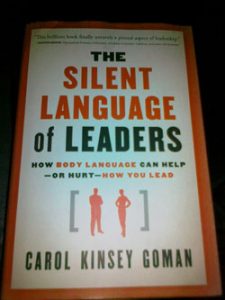The Silent Language of Leaders – How Body Language Can Help – or Hurt – How You Lead
Author: Carol Kinsey Goman
Publisher: Jossey-Bass (Wiley), May 2011
Price: £16.99
Carol Kinsey Gorman posits that it is crucial that leaders are aware of their body language and its impact on behaviour and performance, writes Carl Hubbard.

The author sets out her stall early in this book namely the power of non verbal communication in assisting leaders to lead and effect behaviours that deliver positive results.
“A great leader will find ways to align their body language with the message they want to deliver, and are implicitly aware that it impacts colleagues, clients and staff.”
The book also demonstrates that negative non verbal communication can hinder good performance. Accordingly, the writer posits that it is crucial that leaders are aware of their body language and its impact on behaviour and performance.
 The book offers physiological analyses of non-verbal communication (the author uses that term more often than “body language”).
The book offers physiological analyses of non-verbal communication (the author uses that term more often than “body language”).
It opens with an analysis of the “three brains” possessed by us all:
- The ancient reptilian brain controlling bodily functions, it is the part programmed to help us survive
- The cortical brain is the repository for our conscious thoughts, for our reasoning and intelligence
- The limbic brain is the emotional part of our brain, it is where we make value judgments that influence our behaviour in everyday situations. It is responsible for generating and responding to non-verbal signals and processing responses to non-verbal communication.
The author demonstrates how to use body language in negotiations to get the result you want. She also describes how to use body language to effect change in behaviours among staff. The “five mistakes people make reading your body language” and the “four tips for reading body language” are invaluable aids to any aspiring leader.
The relevance of body language in allowing people to assess the sincerity of the message is highlighted. How you say what you say – intonation, pitch, pace, clarity, etc. – enables people to “read” your voice for concealed meanings or hidden agendas.
Men versus women as leaders comes into focus in the latter part of this work and differences in their non verbal communication are examined. In summary, women understand people better, are better readers of body language, and also have a better understanding of the necessity for collaboration. The power of body language in this era of modern telecommunications with an increasing reliance on teleconferencing and video conferencing is also considered.
This is an instructive book and if you take anything away from it – and you will take much – these two lines are food for thought:
- Good leaders make people believe in them
- Great leaders make employees believe in themselves
Other essential new leadership titles, all published by Jossey-Bass/Wiley this year include:
The Performance Pipeline – Getting The Right Performance at Every Level of Leadership by Stephen Drotter (£19.99) – This book defines the results and measurements required at each leadership level to bring organisational success.
The Five Practices of Exemplary Leadership series of 16-page articles by Kouzes and Posner uses their “Five Practices” leadership model. They feature two on healthcare-related topics, nursing and healthcare in general, each with two brief case studies, a short description of the “Five Practices”, a section on learning to lead, and background information on their “Leadership Practices Inventory” (£6.99 each).
Why Are We Bad at Picking Good Leaders? – A Better Way to Evaluate Leadership Potential by Cohn and Moran, £18.99, includes first-hand stories of real leadership challenges faced by some of today’s most recognisable names.
The Health Care Data Guide – Learning from Data for Improvement by Provost and Murray teaches healthcare professionals how to use statistical process control to effect improvements in their organisations.
Carl Hubbard, National Tobacco Control Office, HSE.

